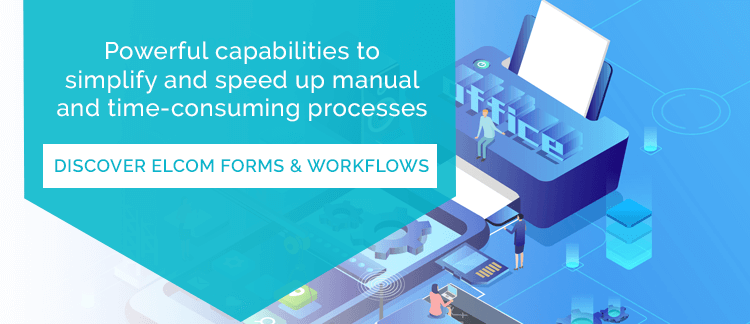Organisations are being weighed down by inefficient manual, siloed and paper-based processes.
From filling out repetitive paper forms to double handling data and spending several minutes finding information - even the simplest manual tasks when done over and over, can waste an enormous amount of time and resources.
According to market research firm IDC, companies lose 20 to 30 percent in revenue every year due to inefficiencies. It’s in every organisation’s interests to explore how information technology improves business processes.
How Intranets Can Improve Business Processes?
Want to improve productivity? Start managing internal processes better! Many of these routine tasks can be automated and streamlined with an intranet managed via a content management system (CMS). These sometimes lesser known CMS features can significantly improve the employee experience for your entire workforce.
Let’s take a closer look at business process improvement methods across different departments within your organisation, that you can implement using your intranet.
Human Resources
A good intranet will automate and optimise business process improvement across content, documents, forms, events, projects, HR and learning management.
Individual employees, managers and HR functions need to complete a lot of people-related processes. These include appraisals, manager approvals, updating HR information, applying for jobs and getting promoted.
With so many HR transactions to complete, both simple and complex, the intranet makes life easier for everybody. Most often intranets are used for online forms and workflow automation to improve HR business processes. The intranet also provides several more benefits as shown below.
By supporting employee and manager self-service, the intranet empowers staff to complete simple tasks themselves and relieve the burden on HR professionals.
How you can use your intranet to help
- Streamlining simple approvals for HR-related requests using custom online forms and associated workflows
- Simplifying more complex HR processes, such as 360-degree appraisals, so they are more efficient
- Distributing key HR reference information targeted to different groups to reduce the number of questions to HR staff
- Encouraging employee self-service through integration with or deep linking to the HR system or portal
- Setting up a 'social' channel to submit questions to HR specialists
- Providing a community space for HR professionals to discuss issues and share ideas between themselves
- Delivering HR-related updates and reminders to staff
- Managing compliance where an HR policy or document must be read, where staff click to acknowledge they have read it
Example use cases
- Approve employee annual leave
- Access the HR system to update address details
- Access information on the process to apply for maternity leave
- Ask a question about pay to an HR professional
- Forum for HR professionals to share insights
- Annual employee survey

Recruitment and Onboarding
Joining a company can be bewildering, with a multitude of people to meet, a huge list of tasks to complete and a mountain of knowledge to assimilate, all at the same time! An intranet can help you master the employee onboarding process and increase workforce engagement.
Making new employees feel welcome when they first join helps deliver a great digital employee experience and allows new employees to get up to speed more quickly, increasing productivity and retention.
This is easier said than done when you have staff working across several locations – including their homes.
Intranets can be key to helping a distributed workforce. Every intranet should make it easy to access resources and make connections by having a dedicated area to give new staff an overview of everything they need to do, pointing to the 'need to know' deeper organisational information and also making them feel part of the organisation. It’s even better when the content is personalised to their group or role.
How the intranet helps
- Providing a checklist of all the tasks that need to be completed and providing relevant information on the required steps
- Supporting key processes and tasks for new hires such as ordering IT equipment via forms and workflow
- Linking to key information about the company, its history, structure and strategy to help employees get up to speed
- Providing online training via a learning management system that is integrated to the intranet
- Providing additional learning resources for new employees through videos, interactive quizzes and other content
- Welcoming new employees, for example with a special video from the CEO
- Facilitating connections by encouraging new employees to complete their own profiles, find out who’s who and join relevant communities
Example use cases
- Complete HR and IT-related tasks
- Get background on company strategy
- Join professional community
- Complete required training
- View welcome message from the CEO
Related resource: [Blog post] Optimising Your Employee Onboarding Workflow with Your Intranet
Information Technology
Intranets help IT departments in a number of ways, including supporting the helpdesk and the use of applications.
An intranet can drive a self-service approach to the use of technology, easing the pressure on the busy IT helpdesk while simultaneously encouraging best practices in using different applications.
The result is a more digitally literate workforce and a more efficient IT department.
How the intranet helps
- Alerting employees with important IT-related messages such as outages or issues being resolved
- Providing user guides, videos and FAQs on different applications and other IT practices
- Facilitating IT-related training
- Streamlining simple processes such as making an IT request or logging a call with the helpdesk through custom forms and workflow
- Providing the front door to the wider 'digital workplace' so employees can easily connect to the applications they use on a regular basis
- Providing social tools to ask questions to IT experts
- Establishing support communities for specialist applications where some questions might be best answered by system owners and super users, rather than the IT helpdesk
Example use cases
- System alerts for outages
- FAQs for common issues
- Report an IT issue
- Access user guides and videos
- Link to applications
- Application support community
Marketing and Communications
Intranets are all about helping employees connect, communicate and collaborate with colleagues - regardless of where they work and when they work. The strength of the connections between employees, teams and divisions is critical for organisations.
Everything from the most basic process to highly sophisticated collaboration between multiple teams depends on efficient and effective connections.
The ability to connect helps build strong communities and supports a positive, energised organisational culture regardless of where employees are working from. Enabling social connections creates stronger workplace bonds, and a sense of team collaboration. It is the key channel to facilitate both formal and informal connections.
At the same time, employees need to be able to connect to both the organisation and to needed resources.
Related resources:
How the intranet helps
- Decentralising communications and enabling departments to take ownership over delivering communications from their department across the business
- Delivering news personalised by role, location and other segments.
- Finding the right person in the employee directory, based on their skills, location, division, role or other attribute
- Accessing contact details to start a conversation
- Facilitating interaction using a variety of social tools, such as blogs and commenting
- Surfacing and sharing conversations across the enterprise in activity streams to enable others to join in
- Supporting communities with a dedicated online space which is open for all to see
- Allowing teams to connect with each other in private dedicated workspaces
- Creating visibility for employee activities through news and events
- Extending connections to employees who are on the go, through mobile access
Example use cases
- Find a colleague’s contact details quickly
- Locate experts to ask questions
- Support Communities of Practice
- Everyday activities of teams
- Discover colleagues with similar interests to you
Customer Service
Intranets are usually only thought of as internal-facing systems but they actually have a direct impact on customer service.
Frontline staff who interact with customers, whether out on the road, in a retail unit or in a call centre, must have access to critical knowledge about products and services. This content needs to be accurate, up to date and easily accessible, so that customer queries can be dealt with in real time.
A great intranet delivers content quickly and efficiently to frontline staff. If needed, the intranet also allows employees to connect with subject matter experts, to help resolve more complex customer queries. In some organisations the intranet also helps account management teams communicate with each other and keep clients happy.
On a more general level an intranet also improves customer service by enabling related training for individual staff, raising general awareness about customer needs, and promoting a can-do and service-oriented culture.
How the intranet helps
- Delivering content about products and services to frontline employees in real time at the point of need to support customer conversations
- Allowing key product knowledge to be kept up to date and accurate via good content management
- Facilitating a search for relevant information in order to meet customer queries and needs
- Connecting staff to the right experts and then enabling relevant conversations to resolve customer issues
- Improving customer service skills through training and increasing awareness of customer issues
- Coordinating communication with teams focused on particular customers
Example use cases
- Conversations with customers at the call centre or on site
- Answer customer questions and resolve issues
- Support account management teams
- Training on customer service skills
- Campaigns to spread
Tip: Beyond your employees, you can create an enterprise portal with similar features and capabilities, to provide all the communications and information external audiences need to provide exceptional customer service. For example, a dealer or supplier portal. Most importantly, you can do so on the same content management system used to manage your intranet!
Related resource: [Blog post] 7 Underrated Ways to Motivate Frontline Employees
Next Steps for Business Process Improvement
These monotonous, low value tasks often consume time that an employee can better use towards higher-value and more interesting and rewarding work - work that fuels productivity and improves an organisation’s bottom line.
A great intranet makes it easier for staff to communicate with each other, makes key processes more efficient and helps them get work done!
Our guide below delves into the 12 key business processes where your intranet can truly deliver value to your organisation.
You'll also find a handy checklist with summary information and space to add your own notes.
Get the guide and start improving key business processes and developing a high-performance culture!
